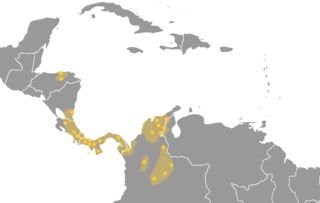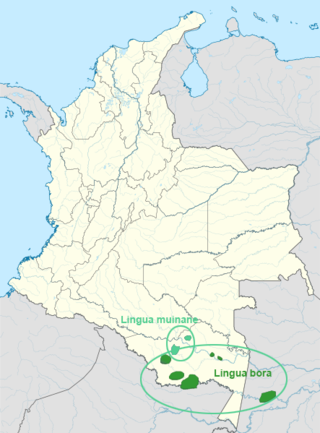Related Research Articles

The Chibchan languages make up a language family indigenous to the Isthmo-Colombian Area, which extends from eastern Honduras to northern Colombia and includes populations of these countries as well as Nicaragua, Costa Rica, and Panama. The name is derived from the name of an extinct language called Chibcha or Muysccubun, once spoken by the people who lived on the Altiplano Cundiboyacense of which the city of Bogotá was the southern capital at the time of the Spanish Conquista. However, genetic and linguistic data now indicate that the original heart of Chibchan languages and Chibchan-speaking peoples might not have been in Colombia, but in the area of the Costa Rica-Panama border, where the greatest variety of Chibchan languages has been identified.

Macro-Arawakan is a proposed language family of South America and the Caribbean centered on the Arawakan languages. Sometimes, the proposal is called Arawakan, and the central family is called Maipurean.
In linguistics, evidentiality is, broadly, the indication of the nature of evidence for a given statement; that is, whether evidence exists for the statement and if so, what kind. An evidential is the particular grammatical element that indicates evidentiality. Languages with only a single evidential have had terms such as mediative, médiatif, médiaphorique, and indirective used instead of evidential.

Maasai or Maa is an Eastern Nilotic language spoken in Southern Kenya and Northern Tanzania by the Maasai people, numbering about 1.5 million. It is closely related to the other Maa varieties: Samburu, the language of the Samburu people of central Kenya, Chamus, spoken south and southeast of Lake Baringo ; and Parakuyu of Tanzania. The Maasai, Samburu, il-Chamus and Parakuyu peoples are historically related and all refer to their language as ɔl Maa. Properly speaking, "Maa" refers to the language and the culture and "Maasai" refers to the people "who speak Maa".
The Maa languages are a group of closely related Eastern Nilotic languages spoken in parts of Kenya and Tanzania by more than a million speakers. They are subdivided into North and South Maa. The Maa languages are related to the Lotuko languages spoken in South Sudan.
The Peba–Yaguan language family is located in the northwestern Amazon, but today Yagua is the only remaining spoken language of the family.

The Yagua language is spoken primarily in northeastern Peru by the Yagua people. As of 2005, it appears that a few speakers may have migrated across the Peruvian-Colombian border near the town of Leticia. A third of the population is monolingual, and Yagua is the language of instruction in local primary schools.
Panare is a Cariban language, spoken by the Panare, who number 3,000–4,000 and live in Bolivar State in central Venezuela. Their main area is South of the town of Caicara del Orinoco, south of the Orinoco River. There are several subdialects of the language. The autonym for this language and people is e'ñapá, which has various senses depending on context, including 'people', 'indigenous-people', and 'Panare-people'. The term "Panare" itself is a Tupí word that means "friend." It is unusual in having object–verb–agent as one of its main word orders, the other being the more common verb–agent–object. It also displays the typologically uncommon property of an ergative–absolutive alignment in the non-perfective aspects and a nominative–accusative alignment in perfective aspect.
The applicative voice is a grammatical voice that promotes an oblique argument of a verb to the core object argument. It is generally considered a valency-increasing morpheme. The Applicative is often found in agglutinative languages, such as the Bantu languages and Austronesian languages. Other examples include Nuxalk, Ubykh, and Ainu.

Pano-Tacanan is a proposed family of languages spoken in Peru, western Brazil, Bolivia and northern Paraguay. There are two close-knit branches, Panoan and Tacanan, with 33 languages. There are lexical and grammatical similarities between the two branches, but it has not yet been demonstrated that these are genetic.
The Waorani (Huaorani) language, commonly known as Sabela is a vulnerable language isolate spoken by the Huaorani people, an indigenous group living in the Amazon rainforest between the Napo and Curaray Rivers in Ecuador. A small number of speakers with so-called uncontacted groups may live in Peru.

Bora–Witóto is a proposal to unite the Boran and Witotoan language families of southwestern Colombia and neighboring regions of Peru and Brazil. Kaufman (1994) added the Andoque language.

Boran is a small language family, consisting of just two languages.

Zaparoan is an endangered language family of Peru and Ecuador with fewer than 100 speakers. Zaparoan speakers seem to have been very numerous before the arrival of the Europeans. However, their groups have been decimated by imported diseases and warfare, and only a handful of them have survived.

Mataguayo–Guaicuru, Mataco–Guaicuru or Macro-Waikurúan is a proposed language family consisting of the Mataguayan and Guaicuruan languages. Pedro Viegas Barros claims to have demonstrated it. These languages are spoken in Argentina, Brazil, Paraguay, and Bolivia.
Kabiye is an Eastern Gurunsi Gur language spoken primarily in northern Togo. Throughout the 20th century, there was extensive migration to the centre and south of Togo and also to Ghana and Benin. Kabiye speakers made up over 23% of the Togolese population in 1999.
Pamela Munro is an American linguist who specializes in Native American languages. She is a distinguished research professor emeritus of linguistics at the University of California, Los Angeles, where she has held a position since 1974.

Kayardild is a moribund Tangkic language spoken by the Kaiadilt on the South Wellesley Islands, north west Queensland, Australia, with fewer than ten fluent speakers remaining. Other members of the family include Yangkaal, Lardil, and Yukulta (Ganggalidda). It is famous for its many unusual case phenomena, including case stacking of up to four levels, the use of clause-level case to signal interclausal relations and pragmatic factors, and another set of 'verbal case' endings which convert their hosts from nouns into verbs morphologically. It is also well-known for only allowing subordination one level deep. Kayardild is the only known spoken language were tense markers appear on both nouns and verbs.
Japhug is a Gyalrong language spoken in Barkam County, Rngaba, Sichuan, China, in the three townships of Gdong-brgyad, Gsar-rdzong and Da-tshang.
Carol E. Genetti is an American linguist who is known for her research into Tibeto-Burman languages and languages of the Himalayans.
References
- ↑ "Doris L. Payne's Home Page". pages.uoregon.edu. Retrieved 2023-05-19.
- 1 2 "Doris L. Payne". scholar.google.com. Retrieved 2023-05-19.
- ↑ "Payne, Doris L. 1985. Aspects of the Grammar of Yagua, a Typological Perspective. UCLA PhD dissertation" (PDF). Retrieved 2023-06-20.
- ↑ "Ph.D. Recipients". Department of Linguistics - UCLA. Retrieved 2023-05-19.
- ↑ "Doris Payne, Ph.D." SIL International. 2012-10-24. Retrieved 2023-05-19.
- ↑ "NSF Award Search: Award # 9809387 - Maa (Maasai) Lexicography and Text Databases". www.nsf.gov. Retrieved 2023-05-24.
- ↑ "Maa Maasai Language Project". pages.uoregon.edu. Retrieved 2023-05-19.
- ↑ "Maa Dictionary: Maasai (IlKeekonyokie, IlPurko, IlWuasinkishu) and Samburu". dokumen.pub. Retrieved 2023-05-19.
- ↑ "NSF Award Search: Award # 1263817 - Documentation and Comparative Lexicon and Morphosyntax of Nivacle and Pilaga, of northern Argentina". www.nsf.gov. Retrieved 2023-05-19.
- ↑ "International Journal of American Linguistics, April 2023".